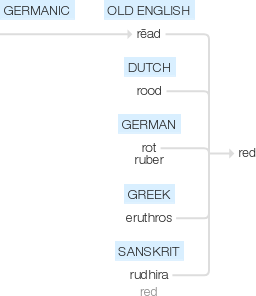Red
Old English rēad, of Germanic origin; related to Dutch rood and German rot, from an Indo-European root shared by Latin rufus, ruber, Greek eruthros, and Sanskrit rudhira ‘red’.
wiktionary
From Middle English red, from Old English rēad, from Proto-West Germanic *raud, from Proto-Germanic *raudaz (compare West Frisian read, Low German root, rod, Dutch rood, German rot, Danish and Norwegian Bokmål rød, Norwegian Nynorsk raud), from Proto-Indo-European *h₁rowdʰós, from the root *h₁rewdʰ- (compare Old Armenian արոյդ/արուրդ (aroyd/arurd), Welsh rhudd, Latin ruber, rufus, Tocharian A rtär, Tocharian B ratre, Ancient Greek ἐρυθρός(eruthrós), Albanian pruth(“redhead”), Old Church Slavonic рудъ(rudŭ), Czech rudý, Lithuanian raúdas, Avestan 𐬭𐬀𐬊𐬌𐬛𐬌𐬙𐬀 (raoidita), Sanskrit रुधिर(rudhirá, “red, bloody”)).
From the archaic verb rede.
red (third-person singular simple present reds, present participle redding, simple past and past participle redded)
etymonline
red (adj.1)
"of a bright, warm color resembling that of blood or of the highest part of the primery rainbow" [Century Dictionary], Middle English rēd, redde, read, reid, from Old English rēad, used of various shades of purple, crimson, scarlet, pink, etc.; also red clothes, dye, ink, wine, or paint, also "having a ruddy or reddish complexion; red-haired, red-bearded;" from Proto-Germanic *rauthan (source also of Old Norse rauðr, Danish rød, Old Saxon rod, Old Frisian rad, Middle Dutch root, Dutch rood, German rot, Gothic rauþs).
This is reconstructed to be from a PIE root *reudh- "red, ruddy," the only color for which a definite common PIE root word has been found. It also is the root of native ruddy, rust, and, via Latin, ruby, rubric, russet, etc.
Along with dead, bread (n.), lead (n.1), its long vowel shortened in or after Middle English. The surname Read, Reid, Reade, etc. represents the old form of the adjective and retains the original Old English long vowel pronunciation. It corresponds to Brown, Black, White; Red itself being rare as a surname. As the color designation of Native Americans in English from 1580s.
In fixed comparisons, red as blood (Old English), roses (mid-13c.), cherry (c. 1400). From Old English as the color characteristic of inflammation, blistering, etc. Of the complexion, lips, etc., "ruddy, rosy, red" (c. 1200); also of person with a healthy complexion or skin color; to be red in the face as a result of powerful emotion or agitation is by c. 1200; to see red "get angry" is an American English expression attested by 1898.
Red as the characteristic color of "British possessions" on a map is attested from 1885. Red-white-and-blue in reference to American patriotism, from the colors of the flag, is from 1840; in a British context, in reference to the Union flag, 1852.
Red rover, the children's game, attested from 1891. Red ball signifying "express" in railroad jargon is by 1904, originally (1899) a system of moving and tracking freight cars. Red dog, type of U.S. football pass rush, is recorded from 1959 (earlier "lowest grade of flour produced in a mill," by 1889). Red meat, that which is ordinarily served or preferred undercooked, is from 1808; the food of wild beasts, hence its figurative use for something that satisfies a basic appetite (by 1792; popular from late 20c.).
Red shift in spectography is first recorded 1923. Red carpet "sumptuous welcome" is from 1934, but the custom for dignitaries is described as far back as Aeschylus ("Agamemnon"); it also was the name of a type of English moth. Red ant is from 1660s.
red (adj.2)
"Bolshevik, ultra-radical, revolutionary," 1917, from red (adj.1), the color they adopted for themselves. The association in Europe of red with revolutionary politics (on notion of blood and violence) is from at least 1297, but got a boost 1793 with adoption of the red Phrygian cap (French bonnet rouge) as symbol of the French Revolution. The first specific political reference in English was in 1848 (adj.), in reports of the Second French Republic (a.k.a. Red Republic).
Red Army is from 1918; Red China is attested from 1934. Red-baiting is attested by 1929. The noun meaning "a radical, a communist" is from 1851.
red (n.)
"the color red; red pigment; ruddiness; red wine," mid-13c., from red (adj.1). Compare Old High German roti, German röthe "redness, red," from the adjective in German. As "a person with red hair" from early 14c. In finance, in the red for "overdrawn, losing money" is by 1926, from the color formerly conventional for recording debts and balances in accounts.
Red is one of the most general color-names, and embraces colors ranging in hue from rose aniline to scarlet iodide of mercury and red lead. A red yellower than vermillion is called scarlet; one much more purple is called crimson. A very dark red, if pure or crimson, is called maroon; if brownish, chestnut or chocolate. A pale red — that is, one of low chroma and high luminosity — is called a pink, ranging from rose-pink, or pale crimson, to salmon-pink, or pale scarlet. [Century Dictionary]
red (v.)
"make red, redden; become red," Middle English reden, redden, from Old English reodan, readian (past tense read, plural rudon), from the source of red (adj.1). In Old English often "stain with blood, wound, kill."
